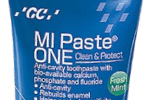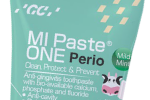MI Paste® products release RECALDENT® (CPP-ACP) - a natural milk protein peptide that adheres to soft tissue, plaque, pellicle, and enamel’s hydroxyapatite delivering amorphous calcium and phosphate (ACP) into the saliva. The mechanism of action is similar to that of the salivary protein statherin and the supply of bio-available calcium and phosphate is able to drive remineralization by Fluoride (MI Paste Plus®, MI Paste® ONE Kids, MI Paste® ONE Perio, and MI Paste® ONE), buffer acid, and reduce the plaque acid effect on tooth structure.
indicates that a major source of mineral loss in the caries process is the destruction of apatite with the creation of water as a by-product, and the leakage of a neutral species calcium hydrogen phosphate across a porous enamel surface.
When placed on the surface of a tooth, RECALDENT® (CPP-ACP) interacts with hydrogen ions and forms the same species calcium hydrogen phosphate which, under a diffusion gradient, can enter the tooth, react with and consume the water to produce enamel mineral, thereby removing subsurface mineral defects.
Any incipient white spot lesions which are developing because of
cariogenic plaque can be treated locally with RECALDENT® (CPP-ACP) to achieve subsurface
remineralization by Fluoride (MI Paste Plus®, MI Paste® ONE Kids, MI Paste® ONE Perio, and MI
Paste® ONE). This may occur in fairly short periods of time – in the order of two to four
weeks.
Caution: RECALDENT® (CPP-ACP) is derived from milk casein. Do not use on patients with a milk protein or hydroxybenzoates allergy. In case of allergic reaction, stop use, rinse mouth with water, and seek medical advice.
Whether you are establishing a preventive care program for your patient, or they are dealing with significant caries, sensitivity or white spots, or gingivitis start the conversation about a family of products that dental professionals around the world trust.

Anticavity Toothpaste with Milk Casein & Bio-available Calcium, Phosphate & Fluoride
Learn More!
An Innovative Combination of RECALDENT® (CPP-ACP) and Stannous Fluoride
Learn More!Dental Professionals: Please fill out the form below for a FREE staff visit for you and your team to learn more about the MI Paste® Family!
By clicking "Submit", you agree to our Terms & Conditions of Use and Privacy Policy .